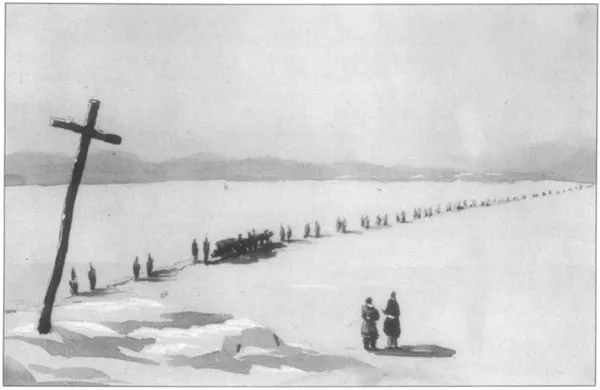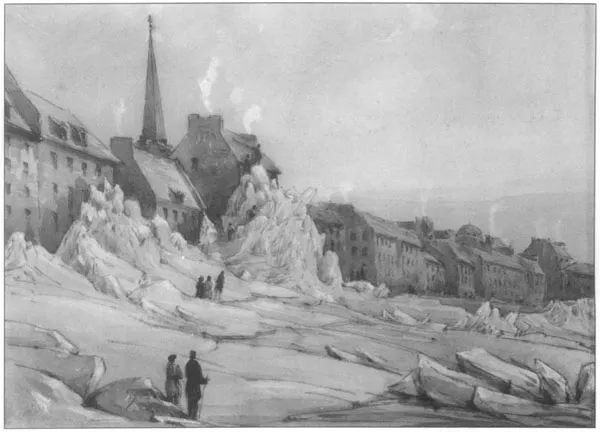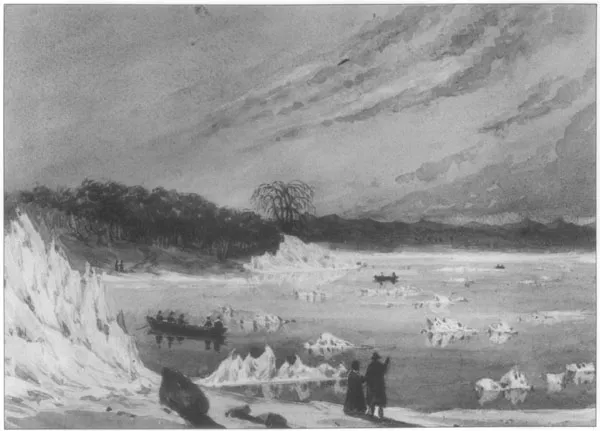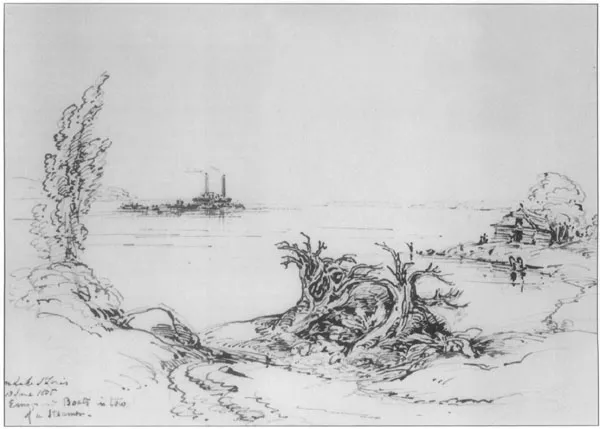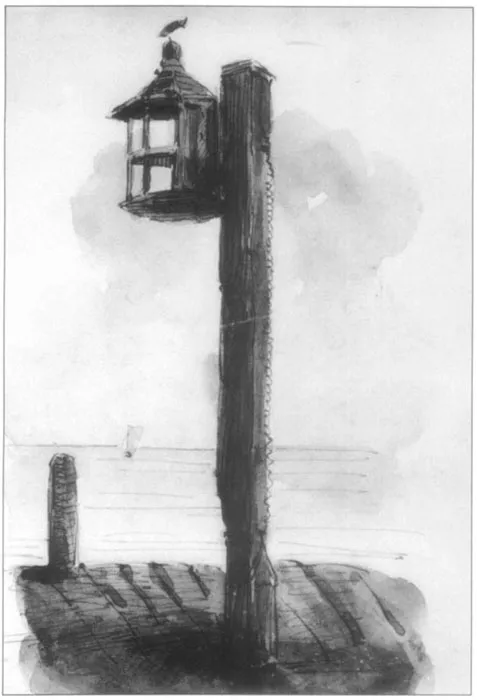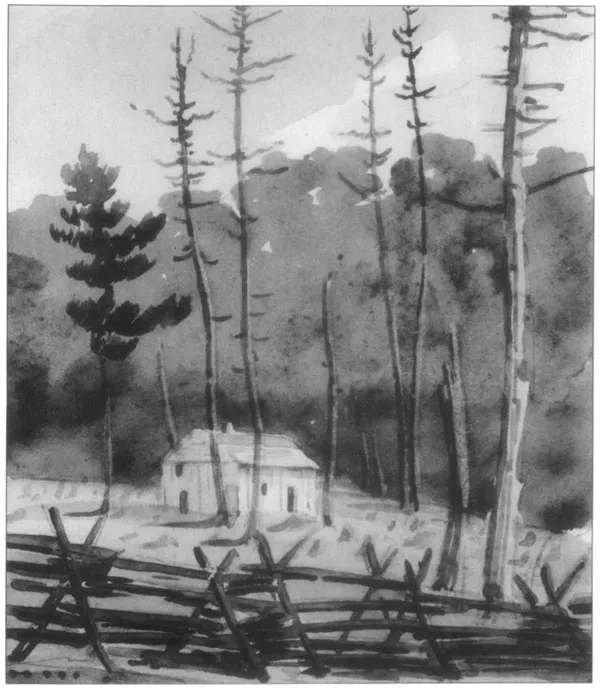![]()
Chapter 3
Montreal and Toronto
Assistant Staff Surgeon Dartnell was ordered to Canada in 1835, along with two other army medical men, to complete the required medical staff for that command. News of their appointments was announced in a letter of 22 May 1835 from Lord Somerset at the Horse Guards in London, addressed to Lieutenant-General Lord Aylmer, Governor-in-Chief of Canada from 1831 to 1835. The men embarked at Cork, 12 June 1835, and arrived in either Quebec or Montreal 21 July.1 Two other official letters mention Dartnell in the military records that year, and indicate that by August he was stationed on the general army medical staff at Montreal.2
Dartnell’s earliest known sketch at Montreal is dated September 1835 (17). It is a competent but summary drawing of unidentified buildings on a shoreline that could be anywhere. Executed in brown ink and wash, it lacks the spirited quality of many of his monochrome studies from India and Ceylon. However, Dartnell’s interest in the theory of watercolour painting was very much alive that season in Montreal. In the back of the small sketchbook he had received in Ceylon, Dartnell had collected some notes on painting landscapes, including a dozen sets of instructions on the composition of a picture, the mixing of colours, and the application of various coloured washes to achieve certain artistic effects. These notes were apparently taken from published articles by such well-known English watercolour painters and teachers as John Varley (1778-1842), David Cox (1783-1859), and Thomas Girtin (1775-1802). Although most of the notes are undated, the fifth was inscribed, “Dublin, September 1834,” indicating that the previous pages were written before Dartnell’s posting to Canada. Of great interest is the seventh entry, entitled “Hints for Drawing in watercolour from Major Young, 79th Highlanders,” and dated September 1835, Montreal. Major Young was probably John Crawford Young (1788-C.1859), a military officer and artist, who was posted to Canada in 1825, and stationed in Quebec, Montreal, Kingston, and York.3 We don’t know whether Dartnell met Young, but Young’s instructions could have been passed on by his fellow artists in Canada, or even by some students, if Young had taught painting there. Young’s advice included such details as:
In figures always use one of the primitive colours – blue, red, or yellow pure, as may be required, reducing with a mixture of the other two. Ultramarine – cobalt – brown madder – for the Sea – Blue, Black, Burnt Sienna, diluted in a Saucer & poured off useful for Skies – Black & Vandyke Brown for Trees – glazed sometimes with blue and gamboge [yellow] –…
The best director, the most perfect guide is lovely nature … Confide in her with a bold head & feel the sentiment of drawing – If possible never let a day pass without drawing something, which if ever so little, will in the end be much –
A long technical treatise on colour mixing by Varley follows, dated Montreal, 22 October 1835. At the end of this Varley suggests, “For sketching from nature the colours should be in small tin boxes. A small portion of white sugar candy dissolved in water will prevent the colours from cracking, & will make them work up easily in the box.” For the outdoor artist Varley advises adding a small portion of a bitter substance (Coloquintida) to watercolours, to prevent flies from sitting on the drawings. And finally he notes that a hole or blemish in a drawing may be filled or covered with pipe clay or tobacco, and tinted over by degrees. In addition to instructions such as these, Dartnell’s sketchbook contains some rough sketches, a tiny study of a sleigh, and one of a pale outline of a sunset at Montreal with instructions dated 31 December 1835, “Horizon glowing – fading upwards into a pale straw colour – clouds brownish grey.”
19. Winter road across the ice, c. 1836
Dartnell soon applied his studies on watercolour painting in a series of Canadian scenes, beginning with dramatic depictions of snow and ice shoves during the winter of 1836. He was obviously so fascinated by the intense brightness and striking formations of the ice shoves surrounding the Montreal harbour and nearby areas that he sketched this subject at least five times that season (20*-24). Equally captivating were the bleak winter roads across wide rivers and lakes (18, 19*), and the spectacular views of floating or berg ice (25*, 26).
The contrast of these brilliant and vivid scenes with those he had sketched in the tropical heat of Ceylon and India is evident in his different artistic treatment of the locales. The eastern landscapes were rendered mostly in pen and ink with monochrome grey or brown washes over graphite, whereas the Canadian views usually show a full range of colours. These, too, were originally composed using graphite in a loose and free drawing style. Occasionally they were finished with monochrome washes, but more often Dartnell worked over the subjects, outlining the important features in loose, linear strokes with pen and ink. He would then fill out or build up his Canadian sketches with watercolour washes of various strengths to form colourful compositions. When dark colour tones, such as browns and greens dominated a landscape, Dartnell often restored a balance by adding bright, motionfilled skies or water. He would also use white bodycolour, or gouache, to suggest or highlight such elements as the foam on top of the waves, the crest of the snow, or the reflections on water. In some works he scraped out the paint down to the white paper, in order to articulate the action of spray, falling water, or smoke. His scraping is sometimes so carefully achieved that it resembles paint applied with a brush.
20. Ice on the wharf at Montreal, 1836
A year after Dartnell’s arrival in Canada, the army returns show that he was still at Montreal on 1 July 1836, but he is listed at the same time as “under orders for Penetanguishene.”4 Perhaps he had some unrecorded leave owing to him, for if the dates on the following sketches are accurate, he was already en route for Upper Canada by the middle of June. On 13 June, for example, he took a small pen-and-ink sketch of some “emigrant” boats being towed by a steamer on Lake St-Louis, just west of Montreal (27*).5 From Montreal, travellers heading west would have gone to Lachine, where they transferred into small steamers, or large, flat-bottomed Durham boats for the journey over the Ottawa-Rideau route to Kingston and beyond.6 Dartnell must have joined one of these groups as he made his way to his new posting at the Penetanguishene garrison. According to a scrapbook notation referring to a sketch now missing, he was at “Mullins” Inn at Lachine on 17 June. Like many of his inscriptions, it is not clear whether that was the actual day he was there, or simply the date on which he finished the sketch. It took longer than three days to reach Niagara Falls from Lachine, and yet 20 June 1836 is the date attached to two very fine Niagara views, effectively finished in brown ink and grey washes (28, 29). The following week he was in Toronto, but unfortunately there are only three sketches from that visit, two of them illustrating waterfront scenes. The first (30*), dated 28 June 1836, depicts a lantern on a pier identified as the King’s Wharf, even though no lantern is known to have existed on that pier. The Queen’s Wharf, which was near the garrison, did have a lantern, however, and is probably the subject of Dartnell’s sketch7. The other Toronto view (31*) is similar in atmosphere to the first, although the scene is not easily identified. The date 1836, in graphite, might have been added later, since the original inscription is in ink. If it was noted in error, the view could also date 1838 or 1843, the two other years that Dartnell was in Toronto. The third sketch (32) is a rough pen-and-ink drawing with graphite of a cart with two horses. The style is loose, and the work was obviously finished quickly.
Public Archives of Canada C-107621
25. Berg ice on the St. Lawrence at Montreal, 1836
27. Emigrant boats on Lake St-Louis, 1836
According to an inscription from another missing sketch, Dartnell was at Crew’s Inn, between Toronto and Newmarket, on 3 July 1836. If the inscribed date is accurate, two days later Dartnell was on the north shore of Kempenfelt Bay, Lake Simcoe, busy sketching the residence of a member of Parliament, Mr. James Wickens (33*).8 Dartnell may have stayed a day or two in Wickens’ large, two-storied frame house, for he did not reach Georgian Bay until two days later.
30. Lantern on a wharf at Toronto, 1836
31. At Toronto, 1836
33. Residence of James Wickens, Lake Simcoe, 1836
![]()
Chapter 4
Penetanguishene
Dartnell probably travelled north to Penetanguishene from Barrie on Lakes Simcoe and Couchiching to the site of present-day Orillia. After taking the twenty-four-kilometre portage overland from there to the Coldwater River, he could then proceed by canoe to the river’s outlet at Matchedash Bay into Georgian Bay, where he stopped to sketch (34). He most likely visited the village of Coldwater, which had opened its first post office as early as 1830, and also served as Indian agency from that year until it was transferred to Manitoulin Island in 1836. From the shore near Coldwater, it was about thirty kilometres around the coast to the garrison at Penetanguishene.1
Judging by the date on another sketch, Dartnell was back in the Barrie area at Kempenfelt Bay again on 24 July 1836, perhaps to meet his wife and young children from Montreal or to pick up supplies. The depot for the military stores was at Kempenfelt, at the base of the Penetanguishene Road.2 The British garrison of Penetanguishene to which Dartnell was ordered was still a small outpost, although it had changed considerably since its founding as a naval base after the War of 1812. Originally built for shipbuilding and as a supply centre for the defence of British North America’s posts farther north and west, it was also a defence backup for the vulnerable town of York on Lake Ontario, during those years of tension between the British and the Americans.
Naval personnel and their staff, including shipwrights, blacksmiths, and clerks, were the first to inhabit the post, which was operational from 1817. It was also used over the years as the home base for special expeditions. Admiral Henry Bayfield stopped there as a y...

